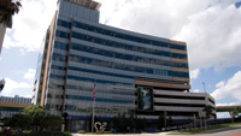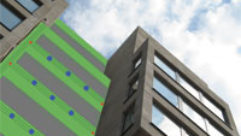
Expert Viewpoint: The Green Push
May 12, 2009 12:00 PM,
By Jon Melchin
How AV can improve sustainable design

Advances in control systems can offer technologies that conserve energy in a buildings seeking Leadership in Energy and Environmental Design (LEED) certification. Some AV fixtures, such as this floor box from FSR, may use recycled
materials, which helps with LEED scoring.
Photo: FSR
Green building is a new, growing trend, right? Wrong. It’s no longer merely a trend—green building techniques are now all grown up, and they have become an integral aspect of today’s construction practices. The built environment has a profound impact on our natural habitat, economy, health, safety, and productivity. Sustainability has been elevated by heightened interest not only from designers, but also among building owners, contractors, consumers, and governmental agencies.
In the United States and worldwide, buildings are a massive source of air pollution and greenhouse-gas emissions, and the U.S. Green Building Council (USGBC) has been extremely successful with the widespread adoption of the Leadership in Energy and Environmental Design (LEED) rating system. Projects can receive LEED certification, which means an independent third party has verified that a building is environmentally responsible, profitable, and a safe, healthy place to live, learn, and work.
With mandates for LEED-certified buildings coming from cities, states, towns, and governmental agencies (see LEEDing the Way), the USGBC is being swamped with new registrations for LEED certification. LEED is continuously evolving to address various project types—new construction, existing buildings, commercial interiors, core, and shell—as well as targeting specific markets including corporate spaces, schools, healthcare facilities, retail venues, and residential projects. The 2009 version, dubbed LEED v3, was recently established to allow additional flexibility and to embrace new technologies, materials, and advancements in construction science while prioritizing energy-efficiency and reducing carbon dioxide emissions.
So, in the context of where the industry is heading with LEED and the rising green tide generally, how can AV affect green building design?
AV’s Green Potential
Now more than ever, audiovisual and presentation technologies are fundamental business tools, and they have a substantial impact on the performance of a building, especially intelligent green buildings. Not only are these structures designed to be environmentally friendly, but there is major focus placed on producing healthy, safe spaces where occupant productivity can flourish.
Buildings represent nearly 40 percent of our total energy consumption, and almost 90 percent of our lives are spent indoors, so efficient and healthy buildings are a priority with respect to air quality, thermal comfort, and natural day lighting. In many buildings, AV, communication systems, control and information technologies, and certainly security are critical to business.
The mainstream green movement has increased the demand for energy-efficient and environmentally friendly products. Building-product manufacturers are focused on producing green products such as materials containing fewer volatile organic compounds (VOCs), products made with recycled content, and certified wood. From this, the term “green AV” was applied to describe systems that incorporate audiovisual technologies that not only have an effect on high-performance buildings, but can contribute to environmental and energy conservation and asset management, as well as maximize operational efficiencies.
Advances in control systems that conserve energy through automation of power switching, lighting, drapes, and thermostats based on time and occupancy levels are helping AV to play a role in green building initiatives. For example, room-scheduling software can be programmed to turn the lights on in a conference room 10 minutes before the start of a meeting and adjust the room temperature automatically. Plasma screens and LCD panels are more energy-efficient than old CRT-based devices, which can mean a lower heat load that allows for smaller HVAC equipment. In addition, these monitors can be used effectively with digital signage to display public information where natural daylight is being designed into the space.
Expert Viewpoint: The Green Push
May 12, 2009 12:00 PM,
By Jon Melchin
How AV can improve sustainable design

Sourcing systems made in the United States, such as this BMS-1032 background music system from FSR, can help reduce transportation costs, which can improve LEED scores.
Photo: FSR
How AV can affect LEED
The LEED rating system awards points in the following categories: Sustainable Sites, Water Efficiency, Energy and Atmosphere, Materials and Resources, Indoor Environmental Quality, and Innovation in Design. Depending on the number of points accumulated, LEED awards four levels of certification: LEED Certified, LEED Certified Silver, LEED Certified Gold, and LEED Certified Platinum. There is no specific requirement for AV in the rating system, and a project could potentially achieve LEED Platinum without incorporating any energy-efficient AV components.
Related Links

Installation Profile: LEEDing the Way
The Bank of America (BOA) Tower sleekly shoots 1200ft. above the traffic heading uptown on Manhattan’s Sixth Avenue…

The Buzz: Installation Spotlight: The Sound of Green
Pittsburgh is a far cry from the city that has, up until recent years, been known as The Smoky City because of the steel industry’s presence. Situated in the East End of the Golden Triangle, Pittsburgh’s downtown, (PPU) is fast becoming a key player in the city’s effort to revitalize downtown and clear the air…

Consumers may not have a lot of green in their wallets, but they still have green on the brain. With Earth Day awareness still fresh in the public conscience, the environmental movement continues to show legs….
That said, there are still areas in which AV could affect a project’s score. Indeed, there are a number of areas where AV technologies can affect LEED credits. LEED offers up to five Innovation in Design points for projects with cutting-edge solutions that offer green benefits. Under the Sustainable Sites category, points are awarded for alternative transportation. Something simple, such as installing a bicycle rack to encourage building occupants to bike to work, can qualify. Demonstrating how videoconferencing and distance learning can reduce an organization’s carbon emissions would be important for a savvy designer. Energy management with AV control systems and other uses of innovative technologies could also offer opportunities for improved scores.
For example, AV systems that are designed to power down automatically may be beneficial. Use of Energy Star-compliant products could also address energy-efficiency requirements. Using certified wood encourages environmentally responsible timber management by specifying wood products from certain sites. AV furniture such as media lecterns and smart desks and tables could also apply. Low-emitting materials that reduce the presence of VOCs, such as urea-formaldehyde, can also be used. Composite wood that eliminates VOCs from adhesives and finishes could qualify for improving indoor air quality. Projects incorporating such materials seek to reduce the use of finite raw materials with rapidly renewable ones. Green AV products that use recycled metal, plastic, and organic-texture wood can fit into this category.
In the Materials and Resources category, points are offered for percentages of the combined value of construction materials and products that are extracted or manufactured within 500 miles of the project, supporting the local economy and reducing the environmental impact resulting from material and equipment transportation. In other words, AV manufacturers can be green just by being in the right place at the right time.
Points are also awarded to a project that appoints a LEED Associated Professional (AP) to the green team to oversee the certification process and help identify areas of qualification. Many AV professionals, including this author, are finding value in being accredited with LEED AP status and have made strides in taking the test required for certification.
Expert Viewpoint: The Green Push
May 12, 2009 12:00 PM,
By Jon Melchin
How AV can improve sustainable design
Green AV Summit
In October 2008, a group of InfoComm International members convened at a LEED Certified Platinum facility in Atlanta that is the headquarters of Southface, a nonprofit organization that provides sound environmental education and outreach programs that promote sustainable practices. In the daylong meeting, the group discussed the current and future position of the audiovisual industry in the green movement. The Green AV Summit members considered various ways the AV industry can contribute to a sustainable future and generated ideas on how to get there. The group identified five areas where the AV industry can contribute:
- Lighting control and devices: how AV control technologies affect more sustainable instruments
- Energy Star/energy-consumption information: how AV products can become Energy Star-compliant and consume less energy
- Green processes and products: how AV companies can incorporate processes that recover waste, recycle products, and use fewer virgin materials
- Videoconferencing: how AV can deploy a variety of conferencing technologies as alternative transportation
- Digital signage: how AV, through digital signage, can reduce the use of unrecyclable materials while increasing the impact of the intended message.
These five areas of the explanatory examples are essentially the foundation of the green AV movement and will be used to develop a body of green AV knowledge and best practices. Other initiatives were discussed to use this body of knowledge for the creation of educational and advocacy programs to encourage InfoComm members, the industry, and the industry’s customers to adopt green AV practices. Engagement with the USGBC was also planned. A Green AV Task Force was established from the members of the Green AV Summit meeting.
The Green AV Task Force includes me and the following industry professionals: Randal Lemke, Shana Rieger, and Duffy Wilbert of InfoComm; Scott Walker of Waveguide Consulting; Byron Tarry of AVW-TELAV; Brian Huff of ; Peter Pekurar and Mitch Rosenberg of Christie Digital Systems; Paul Depperschmidt of Polycom; Midori Connolly of Pulse Staging and Events; Elizabeth Taaffe of Sonic Foundry; Jay Rogina of Spinitar; Mark Valenti of The Sextant Group; Barbara Brandt of Emory University; and Kirk Muffley of the Whitlock Group.
Jon Melchin is a member of InfoComm International’s Green AV Task Force and is an advocate of green building practices. He has developed marketing programs and sales strategies to promote AV products for specification within the architectural and design communities, and he frequently contributes editorial material to publications that serve the audiovisual and construction industries. He can be reached at [email protected].










